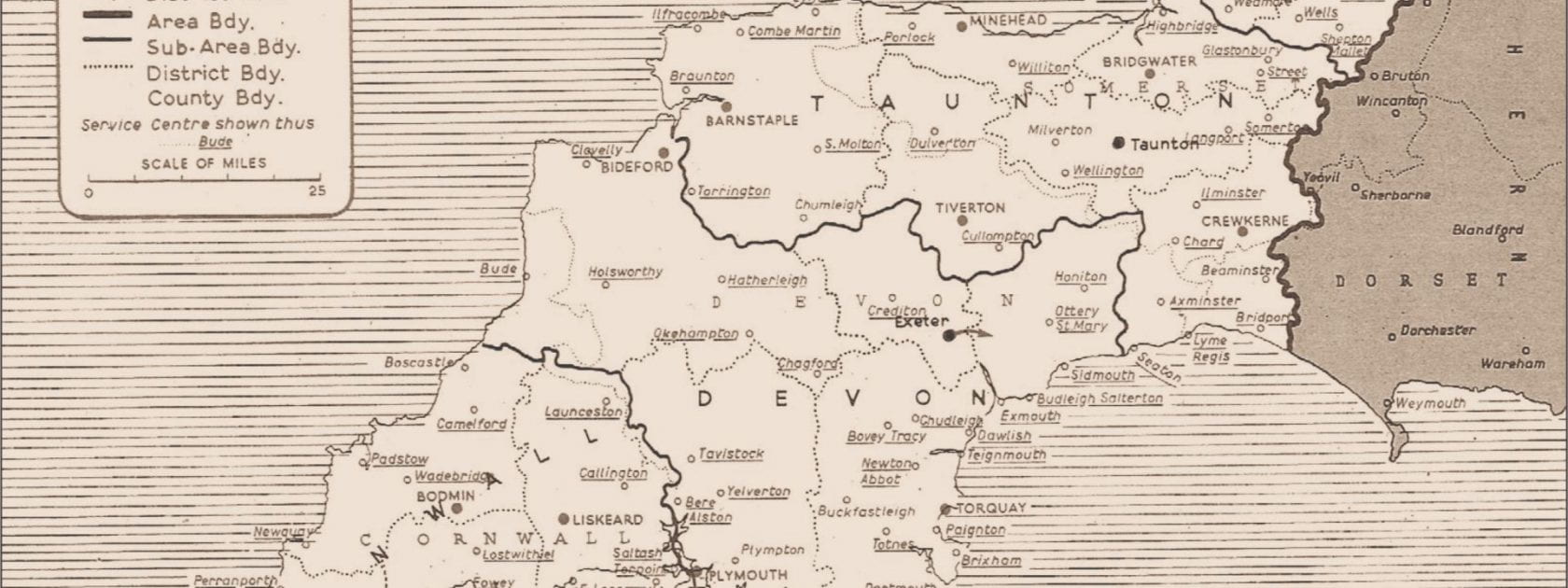When the South Western Electricity Board began operations on 1 April 1948 it incorporated the services and systems of 11 local authorities, 27 companies and one power company.[2] There were enormous variations in the size of the constituent areas. Cornwall Electric Power covered about 1,156 square miles while the Holsworthy company occupied an area of just over one square mile. Bristol Corporation’s electricity department served an area of 100 square miles, considerably larger than the county borough. As in many places, electricity service areas did not always coincide with those of local authorities.
With a total area of about 5,560 square miles and an estimated population of about two million, the South Western Electricity Board had the lowest population density of any of the 14 area boards constituted in 1948. At 376 persons per square mile, this was well below the national average of 704 psm.[3] One implication of this low population density was a high ratio of distribution costs to total revenue. The distinctive economic geography of the South West resulted in a low proportion of industrial sales (30.7 percent) and a correspondingly high proportion of domestic sales (50.7 percent).[4]
Bristol was by far the largest electricity authority in the South West, accounting for about 35 percent of regional sales and 56 percent of generating capacity while serving only 25 percent of the population. As the largest urban centre, Bristol was the obvious place for the South Western Electricity Board headquarters, with its offices in Electricity House. [5]
Table 1 Constituents of the South Western Electricity Board, 1 April 1948
| Local Authorities | |
| 1 | Barnstaple Corporation |
| 2 | Bath Corporation |
| 3 | Bridport Corporation |
| 4 | Bristol Corporation |
| 5 | Exeter Corporation |
| 6 | Lyme Regis Corporation |
| 7 | Plymouth Corporation |
| 8 | Plympton St Mary RDC |
| 9 | Taunton Corporation |
| 10 | Tiverton Corporation |
| 11 | Torquay Corporation |
| Companies | |
| 12 | Bideford & District Electric Supply Co. Ltd |
| 13 | Bridgwater & District Electric Supply and Traction Co. Ltd |
| 14 | Brixham Gas & Electricity Co. Ltd |
| 15 | Bude Electric Supply Co. Ltd |
| 16 | Burnham & District Electric Supply Co. Ltd |
| 17 | Chudleigh Electric Light & Power Co. Ltd |
| 18 | Culm Valley Electric Supply Co. Ltd |
| 19 | Dawlish Electric Light & Power Co. Ltd |
| 20 | East Devon Electricity Co. Ltd |
| 21 | Electric Supply Corpn (Falmouth)1 |
| 22 | Exe Valley Electricity Co. Ltd |
| 23 | Holsworthy Electric Supply Co. Ltd |
| 24 | Ilfracombe Electric Light & Power Co. Ltd |
| 25 | Lynton & Lynmouth Electric Light Co. Ltd |
| 26 | Mid-Somerset Electric Supply Co. Ltd |
| 27 | Minehead Electric Supply Co. Ltd |
| 28 | North Somerset Electric Supply Co. Ltd |
| 29 | Paignton Electric Light & Power Co. Ltd |
| 30 | St Austell & District Electric Lighting & Power Co. Ltd |
| 31 | Salcombe Gas & Electricity Co. Ltd |
| 32 | Seaton & District Electric Light Co. Ltd |
| 33 | South Somerset & District Electricity Co. Ltd |
| 34 | Teignmouth Electric Lighting Co. Ltd |
| 35 | Urban Electric Supply (Dartmouth & Kingswear)2 |
| 36 | Wellington District Electricity Co. Ltd |
| 37 | West Devon Electric Supply Co. Ltd |
| 38 | Weston-super-Mare & District Electric Supply Co. Ltd |
| Power Company | |
| 39 | Cornwall Electric Power Company |
Notes:
[1] Originally vested in South East Scotland Board.
[2] Originally vested in East Midlands Board.
Both undertakings were formally transferred to South Western Board on 5 July 1949.
Source: South Western Electricity Board, First Report and Statement of Accounts for the period 1 January 1948 to 31 March 1949. HC340 1948-9 (HMSO 1949) pp. 26-27. Appendix D
[2] The South West had a low proportion of local authority undertakings (28.2 percent) compared with the national average (64.9) at the time of nationalisation.
[3] SWEB, First Annual Report & Accounts HC240 (HMSO, 1949) p.2.
[4] The averages for the area boards in England and Wales were 34.5 percent domestic and 50.2 percent industrial in 1948/49. Calculated from data in Electricity Council, Handbook of Electricity Supply Statistics 1977 edition, pp.64-65. For general geographies of the region see: A.H. Shorter, W.L.D. Ravenhill and K.J. Gregory, Southwest England (London: Nelson, 1969) and F. Walker, The Bristol Region (London: Nelson, 1972). The coverage of Somerset in this series is disappointing. British Association for the advancement of Science handbooks also provide valuable contemporary material:
C.M McInnes and W.F. Whittard eds. Bristol and its adjoining counties (1955);Barlow ed. Exeter and its region (1969).
[5] Peter G. Lamb, Electricity in Bristol 1863-1948 (Bristol: Bristol Branch of the Historical Association, 1981), pp. 29/.33. The office building on a very prominent site in central Bristol was designed by Giles Gilbert Scott (1880-1960). It is one of his largely unrecognized buildings for the electricity supply industry, being overshadowed by his power station work at Battersea, Bankside, Rye House and North Tees.
[next]


